Abstract
This paper deals with the analyses of batteries used in current military systems to power the electric drives of military vehicles. The article focuses on battery analyses based on operational data obtained from measurements rather than analyses of the chemical composition of the tested batteries. The authors of the article used their experience from the development test-laboratory of military technology. This article presents a comparative analysis of existing and promising technologies in the field of energy storage and buffering for military electric vehicles. The overview of these technologies, including the design, operating principles, advantages, and disadvantages, are briefly presented to produce theoretical comparative analyses. However, this article mainly focuses on the experimental verification of operational ability in varied conditions, as well as the comparison and analysis of these results. The main part of the article provides more experimental studies on technologies of energy storage and buffering using the results of several experiments conducted to demonstrate the behavior of each technology in different working conditions. The output parameters, as well as the state of charge of each technology’s samples, were surveyed in various temperatures and loading characteristics. The results presented in this paper are expected to be useful for optimizing the selection of energy storage and buffering solutions for military electric vehicles in different applications and functional environments.
1. Introduction—Use of Batteries in Military Environment
The battlefield’s form is changing day by day. The development of different scientific and technical disciplines opens up both opportunities and challenges in reducing human casualties in combat. In consequence, one of the military trends that is constantly evolving is the digitization of the battlefield. To give an example, nowadays, all elements of the U.S. Army combat team are interconnected within the digital battlefield to improve combat ability and power, as well as decrease the casualties [1]. The main research, development, and experimentation directions in battlefield digitization can be listed as the following [2]:
- Artificial Intelligence (AI) and Machine Learning (ML);
- Robotics and Autonomous Systems (RAS);
- Networked sensors and effectors;
- Battlefield electrification;
- Novel weapons.
As can be seen from the literature [2], all components of the military are interconnected and linked to the headquarters. This structure allows headquarters to grasp situations and give appropriate commands more easily. Combat elements are also facilitated for better cooperation. Battlefield digitization is obviously closely related to the electrification of the battlefield; in other words, the use of electric vehicles and equipment instead of fossil fuel ones in the military. All the development fields mentioned above require electrical and electronic systems for computing, communication, display, and so on. In addition, compared with traditional fossil fuels, electric power provides huge advantages in performance, simplification, and sustainability. The electrification of the battlefield leads to the issue of energy storage, which accumulates the electrical energy for electrical and electronic systems in military equipment, devices, and vehicles. Figure 1 illustrates the need for energy storage in the modern battlefield. Almost all soldier equipment and military vehicles in every size and every environment require suitable energy storage for their function [2,3,4,5,6,7]. As shown in the cited literature of this article, the authors mainly addressed the use of supercapacitors in electric drives and the sizing of energy buffers [2].
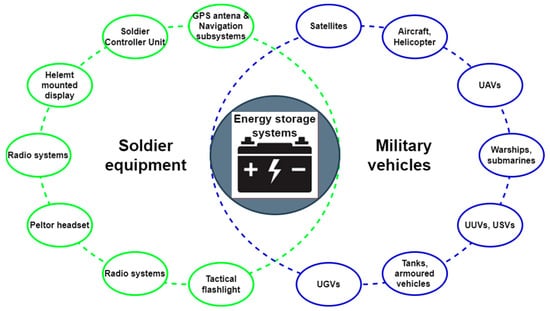
Figure 1.
Modern battlefield structure [8].
Related to the research, development, and experimentation in the RAS field, in the modern battlefield, all the components of the military (air force, ground force, and sea/naval force) combine traditional manned vehicles and emerging unmanned vehicles (UVs)—see Figure 1. The use of military UVs is not only limited to the militaries of large countries but also to small countries. For example, the Army of the Czech Republic or the People’s Army of Vietnam have been, in recent years, integrated into their own traditional structure military UVs for special missions such as reconnaissance, demining, attack, and rescues. For these countries, the recently suitable selection is the use of UVs with small sizes and weights to save the developing costs and developing time, and mainly to save the maintenance requirements. As the solution for these issues, the current trend is to apply these advantages of electrical drives and powers to military UVs to eliminate the disadvantages of traditional internal combustion engines, such as noise, carbon emissions, lower performance, and higher requirements of engine maintenance. Military UVs are classified into four main groups according to their functioning environment: UAVs (Unmanned Aerial Vehicles) moving in the air; UGVs (Unmanned Ground Vehicles) moving on the ground; USVs (Unmanned Surface Vehicles) moving on the sea surface; and UUVs (Unmanned Underwater Vehicles) moving in the water column.
In each category, UVs are categorized based on their weight. For example, the categorization of UGVs is presented in Table 1. The categorization of UAVs can be found in [4]. As mentioned above, the use of electrical drives instead of internal combustion engines can help to reduce noise, carbon emissions, and maintenance requirements. Nevertheless, current technologies in the field of electrical power sources have a number of barriers related to power density and energy density. Therefore, this article focuses mainly on the small and portable UVs with power in the range of some kW, which is advantageous to use hybrid or full electric drives with electrical power sources. Larger UVs with power up to 100 kW are still able to use electric drives, but require power sources with higher energy, so the use of power sources currently is disadvantageous and expensive.

Table 1.
Categorization of AGVs [9].
This article presents the experimental results to compare current energy storage technologies. From the comparison, the ability to use each technology and combine these technologies to eliminate their own weakness is discussed. For example, supercapacitors are favorably used as energy buffers for batteries to provide the ability to charge/discharge with high current levels, which small batteries are not capable of doing. Such a solution is very advantageous for both saving the total weight of the vehicle (huge battery packs are not suitable) and saving energy (the efficiency of supercapacitors is much larger than current batteries) [5,10]. In particular, the literature [2] presents the proposal for a hybrid power supply concept for use by UAV applications.
Furthermore, it should be mentioned here that the studies listed below, which form a treasure trove for our experimentally based analyses, use the findings listed in the references. To summarize the mentioned literature used for the benefit of the article, we can divide it into several focuses. The literature [3,4,5,6,7,8,9,10,11,12,13,14,15,16,17,18,19,20,21,22] is devoted to findings in the field of energy storage, battery construction, battery classification, etc. The literature [16,23,24] deals with the analyzes of the influence of temperature and describes the effects of temperature loading of batteries. Analyses in the field of energy storage, the effects of temperature and detailed description of battery technologies [16,17,18,22,25,26,27], the use of batteries in electric drive applications [4,5,6,7,8,9,14,19,20,21,28,29,30,31], in the field of experimental measurement [7,28,29] and in the field of energy buffers [3,10,28,30,32,33] should be mentioned here. In this article, we mainly focus on the technologies used in a military environment, where the main aim of the article is not to present individual technological solutions. Nevertheless, the emphasis is placed on the experimental verification of selected batteries with reference to the literature that deals in detail with measured batteries. Detailed information about the measured batteries and possible technologies is given in the following section.
2. Introduction—Energy Storage Technologies
2.1. Classification of Energy Storage Technologies
Energy storage technologies play an important role in the field of electrical energy. Firstly, they help to capture generated energy and distribute it effectively for later use. Secondly, they can bridge the gap between the power demand and the quality as well as the reliability of supplied power [11,12,13]. The literature [2] provides an overview of the possibilities of energy storage technologies. According to the form of storage, energy storage technologies can be classified into five main groups, which are basically mechanical, thermal, electrochemical, electrical, and hydrogen-based storage [13,14,15].
Energy storage technologies are very varied and heterogeneous. Their variety depends on applications and working conditions. Practically, working conditions, for example, temperature, must be considered. These technologies are briefly presented and compared to select the most suitable technologies for use in military electric vehicles (EVs).
Mechanical storage technologies store energy in the form of gravitational potential energy (gravity storage technologies), kinetic energy (flywheels), and potential energy of compression (compressed air energy storage or pumped hydro storage).
The principle of thermal storage technologies is that excess electrical energy is used to heat or cool down appropriate special materials. When electrical energy is required, the reverse process is called to recover the energy. There are two forms of thermal storage—sensible thermal storage and latent heat storage [15]. The literature [2] provides a clear classification of energy storage technologies. Electrochemical storage technologies are basically battery technologies that use various electrochemical reactions to convert energy between chemical form and electrical form [4,16]. The battery technologies can be classified according to the materials used for electrochemical reactions. The most used battery types are Lead-acid batteries, Nickel batteries, and lithium batteries.
Electrical storage technologies use supercapacitors and superconducting magnetic systems to store energy in the form of electric and electromagnetic fields. Thanks to the almost-ideal properties of these systems, energy can be stored with minimal loss. However, the price of these “super-systems” is an essential problem. In hydrogen-based systems, electricity is used to electrolyze water into oxygen and hydrogen, which is stored in high-pressure containers for direct combustion or generation of electricity via Fuel Cells.
This paper mainly focuses on electrochemical storage (battery technologies). In comparison to mechanical storage and thermal storage, battery technology is convenient for military use on the battlefield due to its small size, mechanical and thermal stabilization, and easy maintenance (no special materials are required). In addition, this article also shows some achieved results in studies about electrical storage using supercapacitors, and hydrogen-based storage with Fuel Cells. Numerous studies compare the advantages and disadvantages of different energy storage technologies. This article compares and analyses them; however, it mainly focuses on the viewpoint of uses in military electric vehicles.
2.2. Construction of Selected Battery Technologies
The battery is defined as a device that contains energy (in the form of chemical energy) in its active materials. If required, contained chemical energy is converted directly into electrical energy by the electrochemical oxidation-reduction reaction. Each battery contains three main parts [16]:
- The anode (negative electrode) is oxidized during the electrochemical reaction and gives up the electrons to the external circuit (external load).
- The cathode (positive electrode) is reduced during the electrochemical reaction and accepts electrons from the external circuit (external load).
- The electrolyte (ionic conductor) provides the medium for transferring electric charge/ions inside the battery between the anode and cathode.
Batteries are classified into primary batteries, which cannot be recharged electrically in an effective way, and secondary or rechargeable batteries, which are capable of being recharged electrically. Each type of battery has both advantages and disadvantages and can be used in different applications. Primary batteries are inexpensive, lightweight, high-energy-dense, and easy to use. Hence, their common applications are lightweight power sources for portable electrical and electronic devices. In addition, the biggest advantage of secondary batteries is the ability to electrically recharge, which primary batteries cannot have. As a result, rechargeable batteries are suitable for use in energy storage systems.
The main characteristics of a battery depend on its anode and cathode materials. The material used in the battery fundamentally influences the resulting parameters of the battery. For example, using lithium metal oxide or lithium metal phosphate as cathode material can increase the rate capability and cyclability. In addition, they can improve the following parameters: the stability, storage capacities, and rate performance of lithium-ion batteries. However, this article does not aim to focus on the analysis of possible materials to achieve better battery behavior in a military environment but is based on the conclusions of scientific articles focused on improving the stability and rate performance of lithium-ion batteries [17] and recent advances on materials for lithium-ion batteries [18] In addition, we can mention the importance of using material lithiated graphite with regard to achieving lower weight and ability in extreme conditions.
The main battery types in military applications, according to anode and cathode materials, are Lead-Acid, Ni-Cd, Ni-MH, and lithium-ion batteries [4,16]. The literature [16] contains very detailed information on battery technology and also deals with the battery theory, and describes individual technological solutions.
2.2.1. Lead-Acid Batteries
Lead-acid batteries have been the most widely used battery type throughout the history of transportation. Almost all civil and military vehicles traditionally use Lead-acid batteries as the power part of the SLI (starting, lighting, and ignition) system. Another common application of this battery is a power buffer, e.g., in a UPS (Uninterruptible power supply) system. As the cathode material, Lead-acid batteries use lead dioxide (PbO2), while pure metallic lead (Pb) is used as the anode material. The electrolyte of a Lead-acid battery is a sulfuric acid solution. The electrochemical reactions of the discharging process are the following [13,14,15,16,19,20]:
2.2.2. Nickel Batteries
Nickel batteries were one of the most used battery types in the 20th century. Currently, they are still important battery technology in special applications, not only in the military but also in the aerospace field. Figure 2 shows the example of 24 V/22 A Nickel Cadmium battery used in military aircraft, which consists of 20 cells in series.
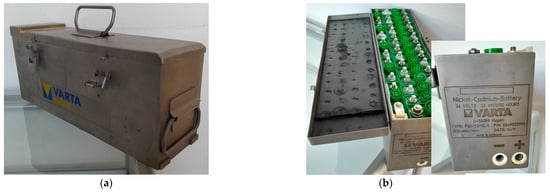
Figure 2.
The Ni-Cd battery in aircraft technology: (a) aviation battery package; (b) internal view of battery cell arrangement.
Unlike Lead-acid batteries, which use dilute sulfuric acid as an electrolyte, Nickel batteries use an aqueous solution of alkali metal hydroxide (KOH or NaOH) as an electrolyte, which brings numerous benefits. Firstly, the electrode materials are less reactive with alkaline than with acidic electrolytes. Secondly, the alkaline electrolyte only transports O2− or OH− ions, and the electrolyte does not change its composition or concentration (compared with the case of Lead-acid batteries). The two most common types of Nickel batteries are Ni-Cd (Nickel-Cadmium) and Ni-MH (Nickel Metal Hydride) batteries.
Ni-Cd batteries use Cadmium (Cd) as anode material, while the cathode is from Nickel(III) oxide hydroxide (NiOOH). The electrochemical reactions during discharging are presented below, which is clear that the alkali metal hydroxide electrolyte is not consumed in these reactions [16,19,21]:
Ni-MH batteries use Metal Hydride as anode material instead of the toxic material Cadmium (Cd), while the cathode is still from Nickel(III) oxide hydroxide (NiOOH). Therefore, the electrochemical reactions during discharging are the following:
where MH stands for Metal Hydride, and M stands for metal [16,19,21].
2.2.3. Lithium-Ion Batteries
Nowadays, the most used battery technology is a lithium-ion (Li-ion) battery. Li-ion batteries exist in almost every electrical and electronic device in the 21st century. Their advantages of small size, lightweight, and high capacity make them very suitable for every application. Their popularity is reflected in varieties of shapes, from small single calluses on portable electronic devices to huge battery packs for demanding use, e.g., in aircraft. Figure 3 shows some different shapes of Li-ion batteries, which are used in laptops, portable electronic devices, drones, and small UVs in our other works [4,5,6,7,8,9,10,11,12,13,14,15,16,17,18,19,20,21,22,23,24,25,26,27,28,29,30,31,32,33,34,35,36,37,38,39,40,41,42]. The construction of two typical Li-ion battery cells—a wound cylindrical cell and a polymer cell is also illustrated in Figure 3. These battery cells can be connected into larger battery packs with higher output voltage (battery cells are connected in series) or higher capacity (battery cells are connected in parallel) or combine these topologies to achieve both higher output voltage and higher capacity. It is necessary to state here that conductivity of electrodes is one of the most important factors affecting the internal resistance of battery in general and Li-ion battery in particular. As shown below, the performance of the battery is significantly affected by its internal resistance. For example, the internal resistance causes internal Joule heating and output voltage drop. Therefore, the conductivity of electrodes is important for the fabrication of Li-ion batteries.
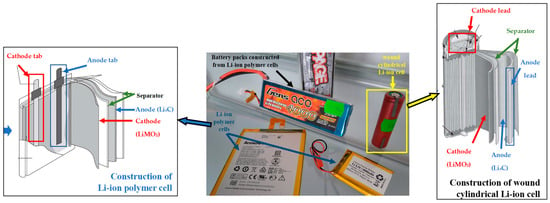
Figure 3.
Typical Li-ion battery cells and their construction [16].
Lithium-ion types of batteries are described in detail in the literature [16]. Regarding the technologies used, we can mention the Lithium-Titanium-Oxide (LTO) technology, which is characterized by a lower nominal voltage. Their advantage is the ability to operate at low-temperature levels. The disadvantage is the low specific energy density (typically 50–80 Wh/kg). Another variant is Lithium-Cobalt (LCO) technology, which achieves good specific capacities. The nominal voltage of the cells is 3.6 V, but the cells have a shorter service life and a low specific power. This technology is currently being replaced with a focus on increasing lifespan and using environmentally friendly materials. Lithium-Manganese (LMO) technology provides higher specific battery capacities and slightly lower specific energy density. The service life is also rather low, but regarding the temperature load, this technology is interesting, as thermal decomposition occurs at temperatures of up to 250 °C [16].
The most successful technology is the Lithium-Nickel-Manganese-Cobalt (NMC) variant, which offers good specific power and energy density, as well as a relatively long service life, which is up to 7–9 times better than the LCO and LMO variants. However, considering the use of cobalt, this option is not promising. That is why Lithium-Iron-Phosphate (LFP) technology is used today and is typically used in traction electric drives. The stability of LFP is better compared to the above-mentioned technologies, and it is higher than 250 °C with respect to thermal decay. The advantage is also the lack of use of cobalt and rare metals in the construction, then the battery can be economically advantageous and also ecological. Lifetime is 2–5× longer compared with NMC. Lithium-Nickel-Cobalt-Aluminum (NCA) technology with a higher specific energy density than NMC is also known [16]. However, thermal decomposition is at 150 degrees. However, the use in the future cannot be assumed with regard to the use of cobalt, but also to thermal decomposition. It is not possible to list all possible variants, but we have only listed the possible types of Li-ion batteries for the needs of electric traction to summarize. To be expected, lithium batteries are based on lithium-sulfur or lithium-air with the aim of achieving higher specific capacities. For the sake of completeness, here we also mention the Sodium-Ion (Na-Ion) variant, which replaces lithium with sodium. So, instead of the lithium cathode, sodium is used. The main advantage of this solution is the natural occurrence of sodium and the ecological aspects. However, in applications for use in electric traction, the Sodium-Ion variant achieves lower energy density and also exhibits lower cycle life. In our article, we do not deal with this technology because they are not used in military technologies and are complicatedly available. However, their development and research can be expected because they reach 3× higher capacity than LTO, similar to LFP technology, but 2× lower than NCA [16]. We can also mention the technological variant Zinc-Ion (Zn-ion), which is a possible alternative to lithium-ion batteries because Zinc-Ion, like Na-Ion, is safer for the need for electric traction. It can be expected that non-lithium batteries will be used in the future with safety and environmental considerations in mind [16]. However, similar to the above conclusion, we do not focus on this technology of non-lithium batteries with regard to their limited use in military technology, but it can be expected precisely for security and safety reasons that they will be deployed in the future.
However, as stated in the introduction, in this article, we try to present the technologies that are currently used on military tricycles, where lithium-based technology has overtaken these days. Therefore, with regard to military needs, technological variants of Li-ion technology prevail. Currently, Li-ion battery technologies based on lithium metal oxide or lithium metal phosphate as cathode material and lithiated graphite as anode material; Lead-acid batteries use lead dioxide (PbO2) as cathode material and pure metallic lead as anode material [16]. The results of measurements conducted on these batteries are presented and discussed in the next chapters.
The cathode material of Li-ion batteries is lithium metal oxide (LiMO2) or lithium metal phosphate (LiMPO4), while the anode material is typically lithiated graphite (LixC). For simplification, the electrochemical reactions of discharging are written for the lithium metal oxide cathode [16]:
As mentioned, one option is to use lithiated graphite. Another possible combination as an anode material is aluminum foil in the fabrication of lithium-ion batteries. Materials that appear suitable for further battery development are aluminum, indium, tin, and lead for direct use as active materials, which can improve the energy density at least 40%. These solutions are better than solutions based on graphite-based techniques. In addition, these materials will allow high capacities and formation efficiencies [22].
The influence of used materials also has an influence on the energy density value. Currently, Li-ion batteries reach the highest energy density values. The energy density of Li-ion cells can reach the value up to 265 Wh/kg. In addition, the density of Ni-Cd batteries, which are currently used in the drives of still-used military systems, can be mentioned. The energy densities of the Ni-Cd batteries are about 75 Wh/kg. This article also addresses the issues of using supercapacitor technology. Supercapacitors reach very low energy density values (about 25 Wh/kg). On the other hand, they excel in parameters of power density and charge/discharge efficiency. The Fuel Cell technology that is also compared in this article with Li-ion batteries reaches values of energy density of about 40 kWh/kg. It is obvious that each technology has its advantages; therefore, for example, some disadvantages of the technology can be compensated by expensive technology (in terms of price and material), or it is possible to use two different technologies (in terms of price and material) in combination so that the resulting properties are better.
In conclusion to this section, we present the chosen main parameters of batteries used to compare Earth-sensitive technologies. One of the parameters is the nominal voltage and nominal capacity of the battery. Lead-acid battery reaches a voltage per cell of 2 V, Ni-Cd 1.2 V, unlike Li-ion technology, which is characterized by 3.6 V per cell. A higher voltage on the cell enables higher power and energy density values, as well as better load voltage limits. Regarding energy density, Li-ion technology achieves the highest values of 200–300 Wh/kg among monitored electrochemical batteries. Fuel Cell technology achieves higher values of energy density. From the point of view of the power density parameter, it appears to be the best technology based on supercapacitors. Very good results were achieved with Li-ion-based technology. The weakest power density values of 50–75 Wh/kg are achieved with Fuel Cells and Ni-Cd and similar battery technologies. As was mentioned above, to evaluate not only the effectiveness of the battery but also from the point of view of the possibility of speed charging, it is necessary to focus on the parameter of the internal resistance of the battery. In this regard, Li-ion, supercapacitors and Lead-acid batteries achieve better values compared with other technologies. The internal resistance parameter is also closely related to the working cycles of the battery together with the material used. Li-ion batteries have a lower number of cycles, but the parameters of the size of the discharge prods and the temperature range can be optimized. Similar to the combination of power and energy density parameters, it can be modified either by using expensive technology or by combining different types of technologies that would help each other to improve the parameters. For example, in combination with supercapacitors, it is possible to improve the parameters of power density and life cycle life of Li-ion batteries. Detailed analyses of different battery parameters are presented below, where we assess individual technologies based on experimental analyses and compare them to theoretical (expected) parameters.
We also focused on electrical parameters for the needs of electric drives. It is also necessary to mention here a parameter related to the logistical use of accumulators in practice, i.e., self-discharge of batteries, which is related to battery storage. The self-discharge effect causes the loss of battery capacity. The self-discharge value of Lead-acid technology reaches up to 4–8% capacity loss per month. Ni-Cd and Ni-Mh technology typically reach values of up to 20–30% of the nominal capacity per month. With Li-ion technology, up to 2–3% per month is achieved. From the point of view of self-discharge, Li-ion technology is the most advantageous. One of the reasons why Li-ion technology is used in the battery market is precisely the fact that it achieves the lowest degree of self-discharge, and this is very important for the needs of logistics in the military.
2.3. Fuel Cell and Supercapacitor Construction
In recent years, the interest in Fuel Cell technology in the automotive industry has been rapidly increasing. Current development in this field opens a huge change to the use of this technology in UVs. The Fuel Cell (FC) is a galvanic device that converts the chemical energy of a fuel and oxidant to electrical energy. The conversion is continuous as long as the fuel and oxidant are fed to the electrodes (from an external source). The difference between FCs compared with batteries is that energy is stored externally, which theoretically allows FC systems to generate electricity continuously. Table 2 presents the main types of FC systems based on the electrolyte materials and operating temperature [4,5,16].

Table 2.
Categorization of FC systems [16].
This article focuses on low-kW UVs; therefore, the most suitable FC type is PEM, which has been designed for low-kW systems. The construction of a small PEM FC is shown in Figure 4, where input hydrogen is stored in hydrogen tanks. Oxygen required by FCs can be supplied from a similar tank or directly from the air. The second solution can cause a lack of oxygen and decrease the efficiency of FCs when EVs operate in an environment with low oxygen concentration, for example, in the case of UAVs and UUVs.
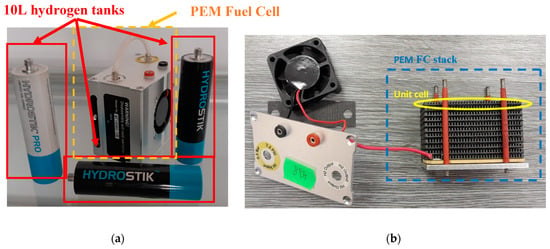
Figure 4.
Construction of a small PEM FC: (a) actual PEM FC; (b) internal construction.
Figure 5 shows the functional diagram and internal construction of PEM FC. Hydrogen, passing through the gas diffuser, reacts on a small circle (called catalyst) at the anode, sending protons and electrons to the cathode. The protons migrate through the membrane while the electrons go through the external circuit (load). The proton reacts with the oxygen supplied at the cathode to produce water, which exits through the gas vent with unused reactants [16].

Figure 5.
Construction of a PEM FC: (a) function diagram [16]; (b) disassembly of the unit cell.
Experimentally verified discharge characteristics of PEM FCs in Figure 4 and Figure 5 are shown below. Figure 6 shows the output voltage and power at room temperature with variable external load.
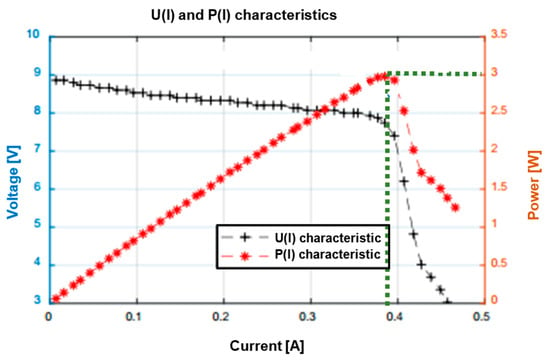
Figure 6.
Dependence of PEM FC output power and voltage on external load (output current; the green dotted line represents the cursor to highlight the maximum power achieved).
The working (operating) temperature of a PEM FC is up to 85 °C. A lower temperature below 50 °C leads to a decrease in the activity (capacity) of the Fuel Cell catalyst, affecting the ohmic polarization and, consequently, the increase in impedance, which leads to an increase in the internal resistance of the Fuel Cell. With higher loading of the Fuel Cell, there is not only a decrease in the overall energy efficiency but also a decrease in the overall efficiency of the cell. However, for the sake of completeness, it is necessary to state that the working temperature range is determined by the material composition of the cell. However, for the sake of completeness, it is necessary to state that the working temperature range is determined by the material composition of the cell. More on Fuel Cell operating temperature versus technology is given in Table 2 and in the text related to the table.
Figure 7 presents our analysis of the effect of the operating temperature of the Fuel Cell below 50 °C, where the above-mentioned degradation is evident and leads to a decrease in the overall energy transformation efficiency. The limit of use of Fuel Cells is 0 degrees, as it is demonstrated in Figure 7.
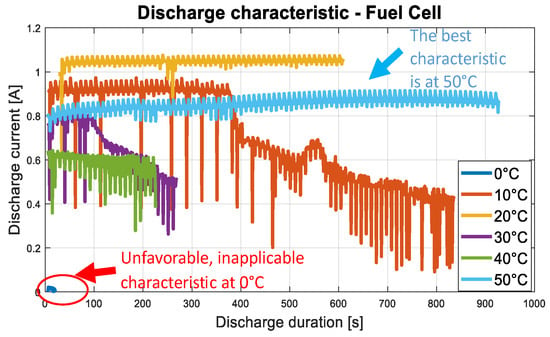
Figure 7.
Dependence of PEM FC discharge characteristic on temperature (constant external load).
Supercapacitors are energy storage devices used to store large volumes of electrical power to improve the power density of the storage systems due to their ability to the high-peak loads (charge/discharge) currents. Supercapacitors are based on Asymmetric Double-Layer Capacitor (AEDLC) technology and use electrodes similar to batteries to achieve higher energy density. These arrangements have little effect on the overall lifetime and, in fact, present similar difficulties as with electrochemical batteries. Supercapacitors have a limited voltage of 2.5–2.7 V. To achieve higher voltage values, supercapacitors are combined in series, but this increases the internal resistance and thus reduces the energy storage efficiency. A series with multiple capacitors requires voltage equalization (surge) similar to Li-ion technology. The specific energy density of the supercapacitor is up to 30 Wh/kg, i.e., 20–40× less than Li-ion batteries.
Constructions of supercapacitors are shown in Figure 8. It is about multifunctional structure supercapacitor with carbon fiber electrodes and structural electrolyte, which can bear the load and provide energy storage simultaneously. This construction is composed of two modified carbon fiber electrodes with an electrically insulating separator in the sandwich structure. Multifunctional structural electrolyte acts as both the electrolyte and the structural matrix. Thanks to their advantages, such as high power density, great mechanical stability, and long cycle life, this type of supercapacitor has been expected to play important roles in a variety of applications [25,26,32].
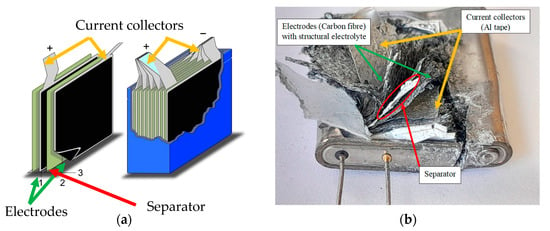
Figure 8.
Construction of supercapacitor: (a) typical construction of plate supercapacitor [33]; (b) disassembly of carbon fiber electrodes plate supercapacitor.
3. Experimental Comparison of Selected Battery Technologies
3.1. Battery Testing Methods
Battery capacity is determined (measured) in relationship to the actual charge that it stored as a function of the current and time. Therefore, capacity is calculated as the integral of the discharge current with the total discharge time. However, the battery capacity parameter does not indicate the amount of useful energy stored in the battery, as it is also affected by the amount of voltage. It is known that higher voltage levels can provide more energy for the same capacity value of batteries. In addition, it is necessary to consider the weight of the battery, which affects the operating parameters of the means where the battery is used. The formula below shows the listed dependencies.
Furthermore, we have to mention the specific power parameter here. Specific power is one of the keys in batteries to describe a battery’s ability to deliver power in relation to its weight and is in relation to the size of the maximum possible load. The dependency is listed below.
From the application point of view, one of the most important energy storage and buffer technology parameters is the usable capacity, or state of charge (SOC). The state of charge of the energy storage unit decides the maximum range in which the vehicle can operate. For that reason, this paper focuses on the experimental analysis of the impact of operating conditions on energy storage’s SOC. The SOC of energy storage and buffer units, however, is not able to be directly measured, it can be only estimated (tested) by measuring other physical parameters of units. The most used testing methods are shown in Figure 9.
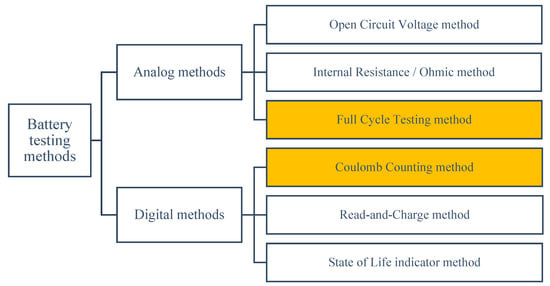
Figure 9.
Battery testing methods [28].
These methods are divided into two main groups. The first one, analog methods, uses directly measured physical quantity to estimate the SOC. In detail, the Open Circuit Voltage method estimates the SOC by measuring the voltage of the energy storage unit while it is disconnected from the external load and comparing the measured voltage to the discharge characteristic of the tested unit. The ohmic method used a special instrument to measure the internal resistance of the energy storage unit. The higher the internal resistance of the energy storage unit, the less power and efficiency it can provide. There are measurement methods based on impedance measurement as well as a function of frequency. The Nyquist plot is used, which is suitable for the evaluation of battery quality degradation and allows the analysis of the effects of battery degradation based on the shape of the characteristic. This article does not use analysis based on this method. We focused on the full cycle testing method for practical reasons. The reason is that we focused more on the practical evaluation of batteries using simpler measuring devices that are generally available in the military environment. The Full Cycle Testing method measures the total time needed to fully charge and discharge the tested energy storage unit. The usable capacity of the tested unit is directly proportional to the time of fully discharged. This method, even though it requires a long time to fully charge and discharge the tested unit, is the most accurate method for estimating the energy storage units’ SOC. It is also used as the calibration for other methods.
The second group, the digital methods, uses a management/control electronic system to estimate and manage the SOC of units. For example, the most used and easiest method is the Coulomb Counting method, which “counts” the amount of electric charge flowing through the energy storage unit. The amount of flowing electric charge is basically integral to the charging/discharging current with the charging/discharging time. The other methods in this group use special filtering algorithms for managing the SOC of energy storage and buffering units to control the charger.
The experiment methodology used in this paper combines the advantages of the Full Cycle Testing method and the Coulomb Counting method. Representatives of different energy storages and buffer technology were fully charged and discharged in predefined conditions. During the charging and discharging processes, the amount of flowing electric charge was monitored to estimate the SOC of each unit. The charging/discharging conditions were also varied to study the impacts of operating conditions.
3.2. Experiment Methodology and Setup
These above-selected energy storage technologies are experimentally compared. An experimental workplace was set up for measuring the discharge characteristics of various types of batteries, supercapacitors, and hydrogen Fuel Cells. Representatives of each technology were discharged with various constant currents. During discharge, their terminal voltage was incessantly monitored. Discharge current was monitored and controlled by using a multimeter with a current shunt and programmable DC load. Terminal voltage is monitored by the multimeter.
The workplace is shown in Figure 10. The measurement instruments were controlled automatically through a workstation/computer with the help of SCPI commands fromMATLAB environment using Instrument Control Toolbox. P. To connect instruments to computers for controlling and transferring data, GPIB and RS-232 interfaces were used. The temperature dependence of technologies’ behavior is one of the most important factors, especially in our case, when the applications in military electric vehicles are the main focused object.
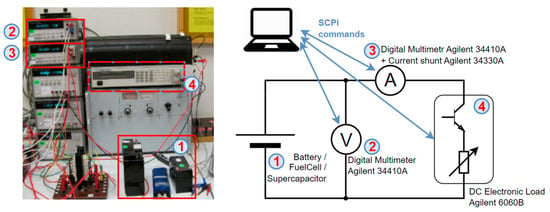
Figure 10.
Setup of experimental workplace.
The approach to battery evaluation is mainly based on operational analyses, which mainly include the effects of temperature and the effect of the size of the load. During the experimental analyses, we used measurements in a temperature chamber and verified the behavior of the batteries in a wide range of temperatures from −50 °C to +80 °C. However, the results presented in the article are measured for the comprehensive assessment of battery technologies for −10 °C, 10 °C, and 25 °C. Temperatures lower than −10 °C show results that are not repeatable, and therefore, we did not include them in the article when evaluating batteries and are influenced by other phenomena. Behavior above +50 °C can be characterized similarly. Similarly, the article dealt with the evaluation of the influence of the load size when the batteries were tested by changing the current size by the values of Ampere units. When using currents above ten Amperes, the measurement method failed, and the complete accumulator composed of individual series-parallel connections would have to be measured.
All the used instruments are driven by using the SCPI standard, encapsulated in the MATLAB or VEEPro programs. The simplified flowchart of these programs is shown in Figure 11.
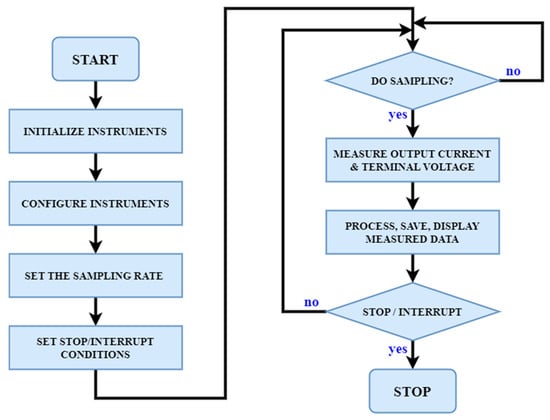
Figure 11.
Flowchart of program driving instruments.
3.3. Lead-Acid Battery
The main advantages of Lead-acid batteries are low cost, good efficiency, good operating reliability, and good output power. However, due to its electrochemical mechanism, deep discharging of this battery type has an impact on the life cycle. Additionally, the sulfuric acid solution electrolyte of Lead-acid battery is one of the most significant disadvantages, while electrodes can react with the electrolyte in an open-circuit state. The reactions of this process are the following:
As a result, the hydrogen evolved from the anode while oxygen is from the cathode. The reaction rate depends on temperature and concentration of acid (the more concentrated the acid is, the higher rate reactions occur). Therefore, Lead-acid batteries, with old technology, require periodic water replenishment and must be stored in the charged state. This is because storing in an uncharged state causes sulphation between the electrode and acidic electrolyte, which leads to damage to batteries [4,19,20,21,30]. Figure 12 presents the results of tested Lead-acid batteries at 10 °C and 25 °C.

Figure 12.
Discharge characteristic of a Lead-acid battery: (a) at 25 °C; (b) at 10 °C.
The discharge characteristics of tested Lead-acid batteries at 10 °C and 25 °C are shown in Figure 12 to show the effects of the load level. Discharge current was set at 1 A, 2 A, 5 A, and 10 A. The effect of the battery’s internal resistance is clearly shown in these graphs. Due to the internal resistance, there is a drop in voltage when the battery is connected to the load and a decrease in battery terminal voltage. The complexity is that, as can be seen in Figure 12, the internal resistance of the battery depends on discharge current and temperature and is difficult to define unambiguously.
Figure 12b does not show another case of charging the battery with a current of 10 A because the internal resistance of the battery has increased, so the battery shows signs of overload. The results of measurements around 10 A are unrepeatable and depend on the current state of the battery.
Figure 13 shows the discharge capacity of the tested Lead-acid battery at 10 °C and 25 °C with the discharging currents 1 A and 2 A. The effect of temperature is clearly realized. In the case of 1 A discharging current, the battery’s capacity at 10 °C is only half of the capacity at 25 °C. The low temperature significantly decreases the efficiency of internal electrochemical reactions, which decreases the capacity of batteries. On the contrary, in the case of 2 A discharging current, the battery’s capacity at 10 °C is higher (120%) than at 25 °C. The reason is that the high discharging current through the internal resistance of the battery causes high Joule heating. While the temperature is lower (10 °C), the Joule heating increases the internal temperature and then also increases the efficiency of reactions. In the case of 25 °C, the internal temperature was also increased by Joule heating but exceeded the ideal operating temperature, and then caused the decline of capacity.

Figure 13.
Discharging capacity of a Lead-acid battery at 25 °C and 10 °C: (a) 1 A discharging current; (b) 2 A discharging current.
3.4. Nickel Batteries
Ni-Cd batteries were invented in the early 20th century, to eliminate the disadvantages of Lead-acid batteries, such as deep-discharging and storing in uncharged state problems. Moreover, long life cycles and a wide range of operating temperatures are other strong points of Ni-Cd batteries. However, they have several disadvantages, like higher cost, lower power density, and lower voltage per cell. The most critical disadvantage is called the “memory effect”, which causes the gradual loss of the battery’s maximum energy capacity. In fact, Ni-Cd batteries found their place in a large number of applications, from power sources for portable electrical and electronic devices to applications in transportation, aviation and even aerospace [5,23,26,30,31].
Since the early 21st century, the Ni-Cd batteries have been gradually phased out from application due to the toxicity of Cadmium. The alternative selection was Ni-MH batteries, which do not contain toxic materials. In addition, the “memory effect” has already been removed in Ni-MH batteries, and the power energy density of Ni-MH batteries is almost double Ni-Cd batteries. The disadvantages, compared with Ni-Cd batteries, are higher internal resistance and a significant decline in capacity at low-temperature levels (below 0 °C). The most critical problem is the high self-discharged current, where the stored energy in a Ni-MH battery can be reduced to 5–20% on the first day and after that, up to 30% per month. In addition, the self-discharge rate also depends on the capacity and temperature. In general, the larger the capacity of the battery is, the larger the self-discharge rate becomes. Nevertheless, the Ni-MH battery has been one of the most used battery types, especially in the EV (electric vehicle) and HEV (hybrid electric vehicle) industries. Because of using non-toxic materials, Ni-MH batteries have also been the most common rechargeable cylindrical battery (AA or AAA batteries) for daily and even emergency use in military electrical and electronic portable devices [4,16,19,23,32,33,36,37,38].
Figure 14 presents the experiment results of measuring Nickel batteries’ discharge characteristics. Measurements were conducted at 25 °C on both Ni-Cd and Ni-MH batteries. The characteristics show higher internal resistance of Ni-MH battery in comparison with Ni-Cd. This characteristic is one of the critical disadvantages of Ni-MH batteries while it hinders them from applications requiring high discharge current.

Figure 14.
Discharge characteristic at 25 °C: (a) Ni-Cd battery; (b) Ni-MH battery.
It can also be seen that the terminal voltage of the Ni-Cd battery changed less during the discharge duration. In all the measurement cases, the quick voltage drop is easily found at the end of the discharge process, which can be a useful effect for estimating the SoC (state of charge) or DoD (Depth of Discharge) of batteries in operation.
Figure 15 shows the results of another experiment, where the charge and discharge characteristics of Ni-MH were monitored at different temperatures while the charge and discharge current were kept constant at 1 A. Experiments were conducted at 25 °C, 10 °C, and −10 °C. The dramatic decline of capacity at negative temperature is clearly presented. In discharging duration, the tested Ni-MH battery was able to discharge only about 20% stored energy, in comparison to discharged energy at 10 °C and 25 °C. In charging duration, this decline is even more significant. Even though the battery voltage reaches the higher value at −10 °C, only over 10% capacity of the battery was charged, in comparison to the charged capacity at 10 °C and 25 °C.

Figure 15.
Characteristics and capacity of Nickel batteries at 25 °C, 10 °C, and −10 °C: (a) Ni-MH battery discharging at 1 A; (b) Ni-MH battery charging at 1 A.
Figure 15a also presents the dependence of Ni-MH batteries’ internal resistance on temperature. In the case of constant discharge voltage, the internal resistance generally increases with the decrease in operating temperature.
3.5. Lithium-Ion Batteries
Lithium is the battery technology nowadays, appearing in a huge amount of applications. Lithium is the lightest metal and the least dense solid element, making lithium batteries take advantage of lightweight, high energy, and power density. The energy and power density of lithium batteries can be five times greater than Lead-acid or Ni-Cd batteries. Lithium batteries’ voltage per cell is also higher (3.0 V–4.2 V) in comparison with other types, e.g., Lead-acid batteries (1.8 V–2.1 V) and Nickel batteries (0.85 V–1.35 V) [3,4,5,6,7,16,20,21,27,29,39,40].
The most common lithium battery type is the Li-ion (lithium-ion) battery. In this type, lithium is used in compound forms, which decreases the hazard of lithium disposition. Other advantages of Li-ion are their smaller self-discharging rate and much longer life cycle than other types of rechargeable batteries. On the other hand, Li-ion is a quite dangerous battery type. The ability to discharge at a high rate makes it a high risk of combustion and explosion. Other problems, over-charging, over-discharging, over current, and thermal issues, significantly affect the life cycle and safety of Li-ion batteries. To resolve these issues, a BMS (Battery Management System) is usually required by systems using Li-ion batteries [3,4,5,6,7,16,20,21,27,29,39,40,41,42,43,44,45,46,47,48]. It follows from the above, BMS manages the rechargeable battery (cell or battery pack), protects the battery from operating outside its parameters, manages safe operating, monitors battery state, computes secondary data like the minimum and maximum voltage, state of charge, state of health, controlling battery environment, authenticating it and balancing cells in a battery pack, etc. BMS also reports data via the available communication ports to the HMI interface in an appropriate way. The BMS is an integral part of the Li-ion battery (application) and must be addressed.
Thanks to the above-mentioned benefits, lithium batteries have become the winner in almost all applications. It is easy to name a large number of our daily devices using lithium batteries, e.g., mobile phones, tablets, laptops, and many other portable electrical and electronic devices. Likewise, in transportation, lithium batteries are also common in the HEV and EV industry, in buses, locomotives, and aviation. In recent years, lithium batteries have also been used as energy storage solutions for HRES (Hybrid Renewable Energy Systems) due to increasing concerns about these systems.
In military applications, lithium batteries have been the best solution for dismounted soldier systems because of their lightweight, small size, and high capacity. The rapid increases in using small UVs (unmanned vehicles) in the military also make lithium batteries more important. The small UVs power supply is solved using lithium batteries to save the total weight and guarantee a good power supply. Lithium batteries have also been used as the power source and UPS for radar systems or electronic warfare equipment. In many countries, there is also a trend of replacing Lead-acid and Nickel batteries used in military transportation and combat vehicles with lithium batteries. In the near future, hybrid electric vehicles, or even fully electric vehicles using lithium batteries, have a big potential to become the standard transportation and combat vehicles in many militaries.
To experimentally analyze the properties of lithium batteries, several measurements were conducted. The tested Li-ion battery was discharged at different temperatures with different discharging currents. The selected experimental temperatures were 25 °C, 10 °C, and −10 °C; the selected tested discharging currents were 1 A and 2 A. Experimental results are graphically presented in Figure 16 and Figure 17 with a brief analysis.

Figure 16.
Discharge characteristics and capacity of Li-ion battery discharging at 1 A, 2 A, and 4 A: (a) at temperature 25 °C; (b) at temperature 10 °C.
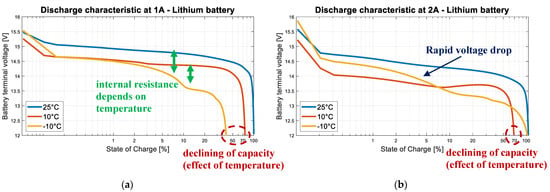
Figure 17.
Discharge characteristics and capacity of Li-ion battery at temperatures 25 °C, 10 °C, and −10 °C: (a) with discharging current 1 A; (b) with discharging current 2 A.
Figure 16 shows the effect of internal resistance on discharge characteristics, which causes a decrease in terminal voltage while the discharge current increases. The measurement results also show that the capacity of Li-ion depends less on the discharge current. At the constant temperature level, the discharged capacities at different discharging currents are different, only less than 10%.
Figure 17 presents the dependence of internal resistance on temperature. At the constant discharge current, the internal resistance generally increases with the decrease in temperature. In low temperatures and high discharge current, it can be seen the rapid voltage drop—see Figure 17b. This characteristic can be critical for such applications requiring smooth supply voltage. It is also clear that temperature has a huge effect on the battery’s capacity. The capacity can be reduced to half when the temperature drops, especially at minus temperatures—see Figure 17a. The reason is that the effectivity of internal electrochemical reactions is lower at lower temperatures.
Figure 17b contains an interesting phenomenon, that capacity at −10 °C is nearly the capacity at 25 °C much better than at 10 °C. The reason is that internal resistance increases at minus temperatures, causing the increase of Joule heating, which increases the internal temperature of the battery and improves the effectivity of internal electrochemical reactions.
Therefore, it can be seen from the stated results, and when comparing characteristics in Figure 13, Figure 15 and Figure 17, that the most striking effect is for the technology with Ni-Cd. For the sake of interest, compare the results of the behavior of supercapacitors. Supercapacitor behavior as shown below, where the effect of temperature is almost invisible (see the results in Section 3.6).
3.6. Partial Conclusion
Figure 18a presents the comparison of selected battery technologies based on the main characters—service life, charging efficiency, power density, and energy density. The comparison shows the outstanding advantages of Li-ion technology, which is the most advantageous technology in almost all criteria. Ni-Cd has a slightly better service life, but its toxicity and the requirements of strictly suitable use to avoid the memory effect decrease the Ni-Cd battery’s service life.
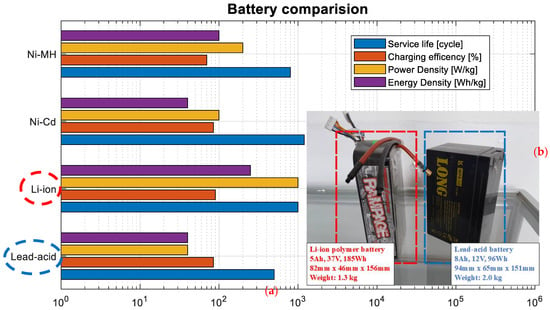
Figure 18.
Battery comparison: (a) based on theoretical main characteristics [3,4,5,16,21]; (b) between currently commercially available Li-ion polymer battery and Lead-acid battery.
Figure 18b shows the comparison between the current commercially available Li-ion polymer battery pack and Lead-acid battery pack. It is obvious that the parameters of the Li-ion battery pack are much better than the Lead-acid battery. Although the dimensions and the weight of the Lead-acid battery are one and a half times bigger than the Li-ion polymer battery pack, the power stored in the Lead-acid battery is only half of Li-ion. The output voltage of the Li-ion battery pack is also three times higher than Lead-acid, making it suitable for applications requiring an electrical source with higher voltage.
Nevertheless, this comparison lacks a price criterion, in which the Lead-acid battery is the winner. For this reason, Lead-acid, the oldest type of battery, still has its own important role in several applications, for example, SLI systems in automotive or UPS systems for military radar stations. The Ni-MH battery is also a good selection for applications that do not require high power density and energy density, for example, fixed UPS stations or HRES systems.
The comparison between Li-ion batteries and supercapacitors is shown in Figure 19. The power density of the supercapacitor is much higher than the Li-ion battery. The service life of supercapacitors is also an outstanding advantage because supercapacitors operate without any electrochemical reaction or changes in materials. The charging efficiencies of Li-ion batteries and supercapacitors are similar and higher than other battery types, making them the most common solution for energy storage. The most significant weakness of supercapacitors is their energy density, which is limited by their capacitance and maximum voltage. In contrast, batteries have better energy density.
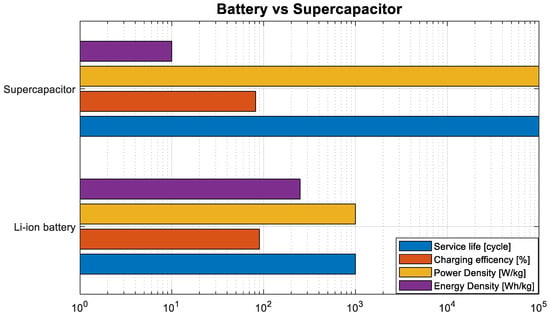
Figure 19.
Comparison between Li-ion battery and supercapacitor.
The comparison between Li-ion batteries and PEM Fuel Cells is shown in Figure 20. Because Li-ion batteries can provide a higher current and a higher output voltage, the power density of Li-ion batteries is higher than PEM FCs. The charging efficiencies of Li-ion batteries and PEM FCs are similar and also similar to supercapacitors’ charging efficiency. As mentioned above, the most significant weakness of supercapacitors is their energy density, which is, in contrast, the most important advantage of PEM FCs, while the energy is stored in the form of hydrogen and oxygen.
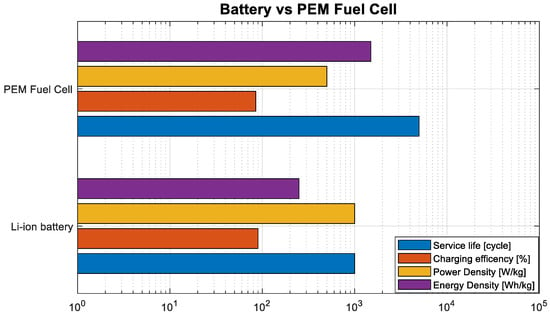
Figure 20.
Comparison between Li-ion battery and PEM Fuel Cell.
For military applications, it is important to study the operating temperature range of each technology. The comparison is shown in Figure 21. In common, compared with other battery types, the Ni-Cd battery and Li-ion battery are the best battery technology in the criteria of operating temperature range, as they can operate in both deeper negative temperatures and higher positive temperatures. Therefore, Ni-Cd has still been the solution for a number of applications with critical operating temperatures, for example, in aerospace and aviation applications. In these applications, the other Nickel battery type—NiMH battery, cannot be used because it is not able to operate in negative temperatures (as mentioned above, its capacity meaningfully decreases in negative temperatures).
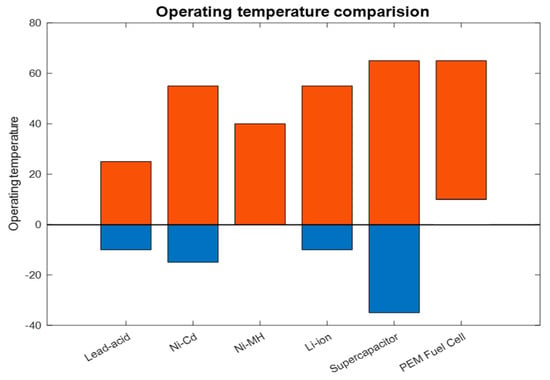
Figure 21.
Operating temperature range of each technology.
The PEM FCs have the similar barrier to NiMH batteries, that they have no ability to operate in negative temperatures. In addition, characteristics of PEM FCs at low-positive temperatures are also very poor—see Figure 21. The winner in this criterion is supercapacitors. Their operating principle is electrically-based so that they can operate from very deep negative temperatures to very high positive temperatures.
Outside of these comparisons, the current biggest barrier to battery technologies is the discharging current limit. Overcharging can cause several critical issues, such as overheating that negatively affects the battery’s heath or leads to combustion and explosion in the most dangerous cases. In the case of FCs, their slow dynamics are their own drawback. Batteries have better dynamics; however, the best solution for applications requiring dynamic behaviors is a supercapacitor. Therefore, it is beneficial to combine batteries with Fuel Cells and supercapacitors in the hybrid power source (HPS) system to eliminate the disadvantages of each by using the advantages of others. Supercapacitors are capable of discharging very high currents and provide very fast response but have limited capacity. In contrast, the battery and FCs have a higher capacity, but the maximum safe discharge current and the rate of response is limited. The typical proposed HPS topology for electrical and hybrid devices is shown in Figure 22.
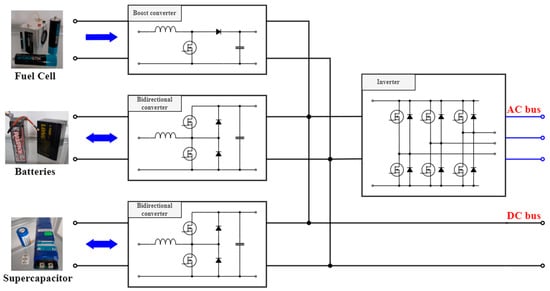
Figure 22.
Typical proposed HPS topology [49].
It can be seen that Figure 22 presents an HPS system with a three-phase inverter converting DC voltage from DC bus to AC voltage for three-phase systems. In common applications, the three-phase system is the most typical. However, in special applications, for example, in military applications, as in our case, the five-phase system is also used. In this case, the inverter topology can be modified by adding two more bridges.
As mentioned in Section 1, it is favorable to use the supercapacitor as an energy buffer for a batteries-based power source—see Figure 23. Supercapacitors’ ability to charge/discharge high currents and their high charge/discharge efficiency help to save the cost and the weight of vehicles, as huge battery packs are not required for high current charge/discharge, for example, when vehicles slow down or accelerate. In case of slowdown, the regenerated energies in the form of high electrical pulses can be stored in supercapacitors and then can be used to charge the batteries with a suitable current.
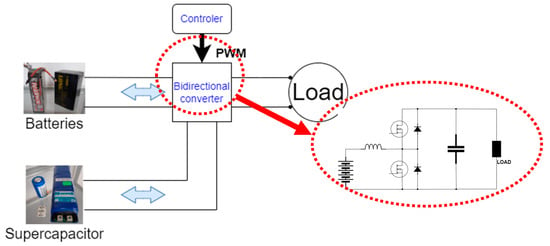
Figure 23.
Supercapacitor as energy buffer [10].
Another advantage of supercapacitors is storage efficiency of supercapacitors depends less on operating temperature because it is electrical storage (instead of electrochemical)—see Figure 24. The experimentally verified characteristics and capacity of supercapacitors at 10 °C and −10 °C are almost similar. The effect of discharging current is also small, circa 10%.

Figure 24.
Discharge characteristics and capacity of supercapacitor 10 °C and −10 °C: (a) discharging current 1 A; (b) discharging current 2 A.
Figure 24 shows the results of the behavior of the supercapacitor depending on the temperature loading and the size of the load current. It is clear that the temperature does not have such an effect on the behavior of supercapacitors compared with electrochemical sources mentioned in the previous text stating the results of the temperature analyses. An example of the effect of temperature in Li-ion is the measurement results shown in Figure 17. Here, the effect of temperature change is noticeable, which is greater compared to supercapacitor technology. Nevertheless, according to the result, the temperature has effects on the size of the internal resistance of the supercapacitor, and this effect increases with the bias current, as is shown in Figure 24. Figure 24 shows the results only for +10 °C and −10 °C because the results for +25 °C were very similar to those for +10 °C. In conclusion, it can be concluded that supercapacitors have a slight influence on temperature at negative temperatures. In addition, the literature [50,51] concerning the self-discharge, experimental, and computational investigation of supercapacitors can be mentioned.
The effects of temperature on the behaviors of selected energy storage technologies are shown in Figure 25. PEM Fuel Cells and supercapacitors are compared with the most used battery technologies in the military, which are Ni-Cd batteries and Li-ion batteries. Obviously, the capacity of supercapacitors least depends on temperature. Their capacitor in a wide temperature range is almost constant. On the contrary, the capacity of batteries significantly decreases when the temperature decreases, especially when the temperature drops below 0 °C. In low-positive temperatures, the capacity of Ni-Cd batteries is also very poor, under 50%, while Li-ion has a better capacity, about 70%. PEM Fuel Cells have inapplicable behaviors at negative temperatures. The output power in these temperatures is practically zero. However, in positive temperatures, the dependence of output power on temperature is less considerable, only 10–20%.
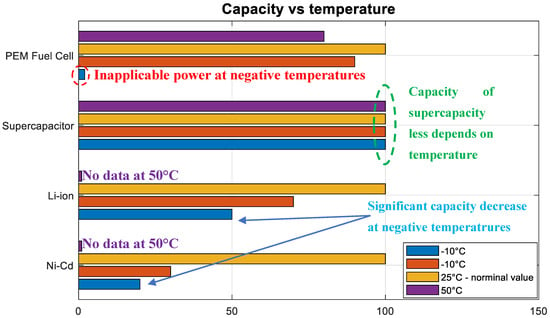
Figure 25.
Effect of temperature on behavior of different technologies.
4. Discussion, Conclusions, and Future Work
4.1. Discussion
This article presents the study of energy storage technologies with a focus on application in military EVs in modern battlefields. With the increasing interest in using EVs in many armies, the maintenance requirements need to be simplified and reduced. One of the most promising ways is to use electrical drives. These solutions are also in the same direction as the trend of battlefield electrification and digitalization. All of them require suitable and advantageous solutions for electrical energy storage. Among the existing energy storage methods, the choices are battery technologies, Fuel Cells, and supercapacitors.
The constructions of the most common battery types and PEM FCs are described in this paper. The materials and fundamental electrochemical reactions of each battery type are also presented. The construction of the PEM FC system is described with the disassembly of the unit cell from the current PEM FC system, which provides a better understanding of its internal structure. Output characteristics of the PEM FC system are experimentally verified. The results show that at 0 °C (and minus temperatures), PEM FC has unfavorable, inapplicable characteristics where the output power is zero. This is an important feature that requires suitable design and construction to use FCs efficiently in cold environments. One promising solution is to use a small secondary heat source to heat the FC system on startup. After the FC system runs, the generated heat can be used to self-warm the entire system, and at the same time, the ventilator is released from the operation, so more energy is delivered to the external load. In addition, the management system, similar to BMS, will be required to manage the parameters of the FC system and regulate the secondary heat source, ventilator, and power electronic part.
The popular and familiar characteristics of each battery type were experimentally verified to provide better knowledge about them. The automatic experimental workplace was set up by using a DC load, multimeters, and the climate chamber to verify the behaviors of batteries in different operating conditions. The program running in the VEEPro environment was used to control instruments and conduct data acquisition. The experimental results are then graphically presented and briefly discussed.
In all measurements, the effect of internal resistance is clearly shown. The internal resistance causes the decrease of terminal output voltage, as well as the Joule heating inside the battery. Joule heating is sometimes useful, as it increases the internal temperature of the battery, making the electrochemical reactions happen with higher efficiency, especially in the cases of minus temperature. On the other hand, when the operating temperature is high, the Joule heating increases the internal temperature to exceed the optimizing temperature and significantly decreases the batteries’ efficiency and capacity. If the Joule heating is very high (over-discharge, overheating), dangerous issues such as combustion and explosion can happen.
The experiment results also show the decline of capacity at minus temperature, in the case of the Ni-MH battery and the quick voltage drop of Ni-MH and Ni-Cd batteries. These characteristics must be carefully taken into consideration to design suitable solutions for the power part of EVs, especially in military EVs. In some cases, the temperature of the battlefield changes rapidly from positive to negative values. The capacity of the Ni-MH battery, in this case, can be reduced to only 10–20% and significantly affect the operation range of powered systems. The capacity and ability to operate at each temperature must be carefully computed to gain higher reliability and efficiency.
Nowadays, battery technology is used in electric military vehicles—lithium batteries are also tested. The experiments are conducted with a Li-ion battery, the most common type of lithium battery. The result shows that at negative temperatures, the capacity of Li-ion batteries also decreases, but to a smaller extent. In the worst case, the capacity reduces to almost 50% (in comparison with 10% in the case of Ni-MH). In other cases, the capacity of Li-ion batteries is reduced by less than 30%. The most important advantages of lithium batteries are their high power density, high energy density, and long service life. These features make the lithium battery the most important battery technology in the 21st century. This is also the most suitable battery technology for AV applications, as the outstanding power and energy density can help to reduce the total weight of EVs and gain high efficiency. Lithium batteries are also the battery used in aviation or automotive industries, where the lightweight and safety features are very important.
This article also presents the behaviors of supercapacitors at different temperatures and discharge currents. The capacity of supercapacitors depends less on temperature because supercapacitors are based on electrical energy storage instead of electrochemical. Although their energy density is much smaller than batteries’, the useful characteristics of capacitors are suitable for applications requiring high-power energy sources. Supercapacitors can be used as the energy buffer for batteries to provide high output current to external load, at the same time, batteries will eliminate the low energy density property of supercapacitors.
These studies are expected to be useful for optimizing the selection, design, and construction of energy storage solutions for different autonomous vehicles, especially for military autonomous vehicles on modern battlefields.
4.2. Conclusions
Detailed analyses of batteries used in electric drive applications in the military field of use were presented. The results present that Li-ion technology is the technology that exhibits good parameters in terms of lifetime, power density, and energy density. The mentioned analyses also show the learned use of supercapacitors for the need to improve the power density of battery systems in combination with, e.g., Li-ion batteries. The use of the concept can also be achieved by reducing the requirements for current-loaded batteries, which affect the total resistance of the battery and, therefore, not only the overall life but also the lifetime. We have also analyzed the capabilities of Fuel Cells in military applications similar to Li-ion batteries using the combination of supercapacitor technology. It can significantly improve performance in practice and reduce the effect of temperature and load product size. Detailed information is provided mainly in Figure 18, Figure 19 and Figure 20.
The final comparison of individual technologies is shown in Table 3.

Table 3.
Comparison of individual technology.
4.3. Future Work
In this article, we look at the environment for experimental verification of batteries used in the military and in military technology. Currently, systems based on electric drives, i.e., based on modern batteries, are also being newly introduced into the armament. Experience with the use of electric drives and battery power systems in the military environment shows the need to focus on safety issues. It is necessary to deal with parameters that influence the total capacity of the used battery drive. Our current work in this area has shown that it is necessary to pay attention not only to questions of the technological development of new batteries with the required properties in the military environment but also to non-traditional ways of using batteries in military practice. We are currently working on measuring the dynamic characteristics of batteries and are preparing the measurements using the Nyquist plot to measure internal resistance for the needs of further analyses in this area.
Author Contributions
Conceptualization, J.L. and N.N.P.; methodology, J.L., R.B. and S.R.; software, J.L. and Q.H.D.; validation, J.L., N.N.P. and Q.H.D.; formal analysis, J.L. and N.N.P.; investigation, J.L. and N.N.P.; resources, R.B. and S.R.; data curation, N.N.P.; writing—original draft preparation, N.N.P.; writing—review and editing, J.L.; visualization, N.N.P. and Q.H.D.; supervision, J.L.; project administration, J.L.; funding acquisition, J.L. All authors have read and agreed to the published version of the manuscript.
Funding
This work was supported under the projects “FEKT-S-23-8162“ and “DZRO-FVT22-AIROPS”.
Data Availability Statement
The raw data supporting the conclusions of this article will be made available by the authors on request.
Acknowledgments
The authors appreciate the anonymous reviewer’s clarifications regarding the manuscript production.
Conflicts of Interest
Author Quang Huy Dong is employed by the Viettel Army Telecommunication Industry Corporation. The remaining authors declare that the research was conducted in the absence of any commercial or financial relationships that could be construed as a potential conflict of interest.
References
- Siegel, N.G.; Madni, A.M. The digital battlefield: A behind-the-scenes look from a systems perspective. Procedia Comput. Sci. 2014, 28, 799–808. [Google Scholar] [CrossRef]
- British Army. BATTLEFIELD ELECTRIFICATION. British Army Approach to Battlefield Electrification. Available online: https://www.army.mod.uk/media/17010/british-army-approach-to-battlefield-electrification.pdf (accessed on 11 December 2023).
- Leuchter, J.; Bauer, P.; Zobaa, A.F.; Bojda, P. An interface converter of hybrid power sources with supercapacitors. In Proceedings of the IECON Proceedings (Industrial Electronics Conference), Glendale, AZ, USA, 7–10 November 2010; pp. 3250–3257. [Google Scholar] [CrossRef]
- Pham, N.N.; Leuchter, J.; Pham, K.L.; Dong, Q.H. Battery Management System for Unmanned Electric Vehicles with CAN BUS and Internet of Things. Vehicles 2022, 4, 639–662. [Google Scholar] [CrossRef]
- Leuchter, J.; Stekly, V. Study on the hybrid power source concept of unmanned aircraft systems. In Proceedings of the 2013 Aviation Technology, Integration, and Operations Conference, Los Angeles, CA, USA, 12–14 August 2013. [Google Scholar] [CrossRef]
- Oman, H. On-board energy and power management on electric vehicles: Effect of battery type. In Proceedings of the 17th DASC. AIAA/IEEE/SAE. Digital Avionics Systems Conference. Proceedings (Cat. No.98CH36267), Bellevue, WA, USA, 31 October–7 November 1998; pp. I43/1–I43/6. [Google Scholar] [CrossRef]
- Gagliardi, F.; Pagano, M.; Maestri, G.; Martone, M.; Tarantino, A. Experimental results of on-board battery-ultracapacitor system for electric vehicle applications. In Proceedings of the IEEE International Symposium on Industrial Electronics, L’Ayuila, Italy, 8–11 July 2002; Volume 1, pp. 93–98. [Google Scholar] [CrossRef]
- Romanenko, I.; Shyshatskyi, A. Analysis of modern condition of military radiocommunication system. Adv. Inf. Syst. 2017, 1, 28–33. [Google Scholar] [CrossRef][Green Version]
- Lopatka, M.J. UGV for close support dismounted operations—Current possibility to fulfil military demand. Chall. Natl. Def. Contemp. Geopolit. Situat. 2020, 2020, 16–23. [Google Scholar] [CrossRef]
- Leuchter, J. Bi-Directional DC-DC Converters for Battery Buffers with Supercapacitor. In Energy Storage in the Emerging Era of Smart Grids; IntechOpen: Rijeka, Croatia, 2011. [Google Scholar] [CrossRef]
- Kalaiselvam, S.; Parameshwaran, R. Energy Storage. In Thermal Energy Storage Technologies for Sustainability; Elsevier: Amsterdam, The Netherlands, 2014; pp. 21–56. [Google Scholar] [CrossRef]
- Mansour, D.E.A. Energy Storage Technologies in MVDC Microgrids. In Medium-Voltage Direct Current Grid: Resilient Operation, Control and Protection; Elsevier: Amsterdam, The Netherlands, 2019; pp. 189–207. [Google Scholar] [CrossRef]
- Hussain, F.; Rahman, M.Z.; Sivasengaran, A.N.; Hasanuzzaman, M. Energy storage technologies. In Energy for Sustainable Development: Demand, Supply, Conversion and Management; Elsevier: Amsterdam, The Netherlands, 2020; pp. 125–165. [Google Scholar] [CrossRef]
- Haidl, P.; Buchroithner, A.; Schweighofer, B.; Bader, M.; Wegleiter, H. Lifetime Analysis of Energy Storage Systems for Sustainable Transportation. Sustainability 2019, 11, 6731. [Google Scholar] [CrossRef]
- Classification of Energy Storage Technologies: An Overview. Available online: https://etn.news/energy-storage/classification-of-energy-storage-technologies-an-overview (accessed on 16 January 2023).
- Beard, K.W.; Reddy, T.B. (Eds.) Linden’s Handbook of Batteries, 5th ed.; McGraw-Hill: New York, NY, USA, 2019; ISBN 978-1-260-11592-5. [Google Scholar]
- Wang, G.; Leng, X.; Han, S.; Shao, Y.; Wei, S.; Liu, Y.; Lian, J.; Jiang, Q. How to improve the stability and rate performance of lithium-ion batteries with transition metal oxide anodes. J. Mater. Res. 2017, 32, 16–36. [Google Scholar] [CrossRef]
- Barbosa, J.C.; Gonçalves, R.; Costa, C.M.; Lanceros-Mendez, S. Recent Advances on Materials for Lithium-Ion Batteries. Energies 2021, 14, 3145. [Google Scholar] [CrossRef]
- Denton, T. Automobile Electrical and Electronic Systems; SAE International: Warrendale, PA, USA, 1995. [Google Scholar]
- Zhu, T.; Boyles, S.D.; Unnikrishnan, A. Electric Vehicle Travelling Salesman Problem with Drone 1 2 3 4. 2019. Available online: https://par.nsf.gov/servlets/purl/10185815 (accessed on 6 April 2022).
- Leuchter, J.; Zobaa, A.F. Batteries investigations of small unmanned aircraft vehicles. In Proceedings of the 2015 International Conference on Clean Electrical Power (ICCEP), Glasgow, UK, 19–21 April 2016; IET—The Institution of Engineering and Technology: London, UK, 2016. [Google Scholar] [CrossRef]
- Heligman, B.T.; Manthiram, A. Elemental Foil Anodes for Lithium-Ion Batteries. ACS Energy Lett. 2021, 6, 2666–2672. [Google Scholar] [CrossRef]
- Park, S.-Y.; Miwa, H.; Clark, B.T.; Ditzler, D.S.K.; Malone, G.; D’Souza, N.S.; Lai, J.-S. A universal battery charging algorithm for Ni-Cd, Ni-MH, SLA, and Li-Ion for wide range voltage in portable applications. In Proceedings of the 2008 IEEE Power Electronics Specialists Conference, Rhodes, Greece, 15–19 June 2008; pp. 4689–4694. [Google Scholar] [CrossRef]
- Org, W.E.; Pierozynski, B. Electrochemical science on the Low Temperature Performance of Nickel-Metal Hydride (NiMH) Batteries. Int. J. Electrochem. Sci. 2011, 6, 860–866. [Google Scholar]
- Qi, G.; Nguyen, S.; Anthony, D.B.; Kucernak, A.R.J.; Shaffer, M.S.P.; Greenhalgh, E.S. The influence of fabrication parameters on the electrochemical performance of multifunctional structural supercapacitors. Multifunct. Mater. 2021, 4, 34001. [Google Scholar] [CrossRef]
- Singhal, S.P.; Alsbach, W.G.; Rao, G. Performance of Nickel-Cadmium Batteries on the Goes i–k Series of Weather Satellites; NASA: Washington, DC, USA, 1998. [Google Scholar]
- Liu, R. Nanostructured Vanadium Pentoxide (V2O5) and Hematite (α-Fe2O3) Hollow Spheres as Electrode Materials for Lithium-Ion Batteries. Master’s Thesis, University of Wollongong, Wollongong, Austraila, 2010. [Google Scholar]
- Battery Test Methods—Battery University. Available online: https://batteryuniversity.com/article/battery-test-methods (accessed on 11 December 2023).
- Pramanik, P.K.D.; Sinhababu, N.; Mukherjee, B.; Padmanaban, S.; Maity, A.; Upadhyaya, B.K.; Holm-Nielsen, J.B.; Choudhury, P. Power Consumption Analysis, Measurement, Management, and Issues: A State-of-the-Art Review of Smartphone Battery and Energy Usage. IEEE Access 2019, 7, 182113–182172. [Google Scholar] [CrossRef]
- Leuchter, J.; Stekl, V.; Bauer, P. Battery-supercapacitors mixed as electrical power buffers. In Proceedings of the 5th IET International Conference on Power Electronics, Machines and Drives (PEMD 2010), Brighton, UK, 19–21 April 2010; Volume 2010. [Google Scholar] [CrossRef]
- Zahran, M.; Atef, A. Electrical and Thermal Properties of NiCd Battery for Low Earth Orbit Satellite’s Applications. WSEAS Trans. Electron. 2006, 3, 340. [Google Scholar]
- Xu, Y.; Lu, W.; Xu, G.; Chou, T.-W. Structural supercapacitor composites: A review. Compos. Sci. Technol. 2021, 204, 108636. [Google Scholar] [CrossRef]
- Supercapacitor Options for Energy-Harvesting|DigiKey. Available online: https://www.digikey.kr/ko/articles/supercapacitor-options-for-energy-harvesting-systems (accessed on 7 February 2023).
- Axsen, J.; Burke, A.F.; Kurani, K.S. Batteries for PHEVs: Comparing Goals and the State of Technology. In Electric and Hybrid Vehicles: Power Sources, Models, Sustainability, Infrastructure and the Market; Elsevier: Amsterdam, The Netherlands, 2010; pp. 405–427. [Google Scholar] [CrossRef]
- Bae, S.-H.; Jeon, C.; Oh, S.; Kim, C.-G.; Seo, M.; Oh, I.-K. Load-bearing supercapacitor based on bicontinuous PEO-b-P(S-co-DVB) structural electrolyte integrated with conductive nanowire-carbon fiber electrodes. Carbon 2018, 139, 10–20. [Google Scholar] [CrossRef]
- Lin, S.-L.; Huang, K.-L.; Wang, I.-C.; Chou, I.-C.; Kuo, Y.-M.; Hung, C.-H.; Lin, C. Characterization of spent nickel–metal hydride batteries and a preliminary economic evaluation of the recovery processes. J. Air Waste Manag. Assoc. 2016, 66, 296–306. [Google Scholar] [CrossRef] [PubMed]
- Young, K.-H.; Cai, X.; Chang, S. Reviews on Chinese Patents Regarding the Nickel/Metal Hydride Battery. Batteries 2017, 3, 24. [Google Scholar] [CrossRef]
- Chang, S.; Young, K.-H.; Nei, J.; Fierro, C. Reviews on the U.S. patents regarding nickel/metal hydride batteries. Batteries 2016, 2, 10. [Google Scholar] [CrossRef]
- Olabi, A.G.; Abbas, Q.; Shinde, P.A.; Abdelkareem, M.A. Rechargeable batteries: Technological advancement, challenges, current and emerging applications. Energy 2023, 266, 126408. [Google Scholar] [CrossRef]
- el Haj Assad, M.; Khosravi, A.; Malekan, M.; Rosen, M.A.; Nazari, M.A. Energy storage. In Design and Performance Optimization of Renewable Energy Systems; Elsevier: Amsterdam, The Netherlands, 2021; pp. 205–219. [Google Scholar] [CrossRef]
- Laadjal, K.; Cardoso, A.J.M. Estimation of Lithium-Ion Batteries State-Condition in Electric Vehicle Applications: Issues and State of the Art. Electronics 2021, 10, 1588. [Google Scholar] [CrossRef]
- Leuchter, J.; Bauer, P. Capacity of power-batteries versus temperature. In Proceedings of the 2015 17th European Conference on Power Electronics and Applications, EPE-ECCE Europe 2015, Geneva, Switzerland, 8–10 September 2015. [Google Scholar] [CrossRef]
- Gabbar, H.A.; Othman, A.M.; Abdussami, M.R. Review of Battery Management Systems (BMS) Development and Industrial Standards. Technologies 2021, 9, 28. [Google Scholar] [CrossRef]
- Chen, Y.; Kang, Y.; Zhao, Y.; Wang, L.; Liu, J.; Li, Y.; Liang, Z.; He, X.; Li, X.; Tavajohi, N.; et al. A review of lithium-ion battery safety concerns: The issues, strategies, and testing standards. J. Energy Chem. 2021, 59, 83–99. [Google Scholar] [CrossRef]
- Wen, J.; Yu, Y.; Chen, C. A Review on Lithium-Ion Batteries Safety Issues: Existing Problems and Possible Solutions. Mater. Express 2022, 43, 32. [Google Scholar] [CrossRef]
- Lamb, J.; Jeevarajan, J.A. New developments in battery safety for large-scale systems. MRS Bull. 2021, 46, 395. [Google Scholar] [CrossRef]
- Wang, Q.; Zhao, H.; Ould Ely, T.; Ely, O.T.; Kamzabek, D.; Chakraborty, D. Batteries Safety: Recent Progress and Current Challenges. Front. Energy Res. 2019, 7, 71. [Google Scholar] [CrossRef]
- Sripad, S.; Bills, A.; Viswanathan, V. A review of safety considerations for batteries in aircraft with electric propulsion. MRS Bull. 2021, 46, 435. [Google Scholar] [CrossRef]
- Amin; Bambang, R.T.; Rohman, A.S.; Dronkers, C.J.; Ortega, R.; Sasongko, A. Energy management of fuel cell/battery/supercapacitor hybrid power sources using model predictive control. IEEE Trans. Ind. Inform. 2014, 10, 1992–2002. [Google Scholar] [CrossRef]
- Ratha, S.; Sahoo, S.; Mane, P.; Polai, B.; Sathpathy, B.; Chakraborty, B.; Nayak, S.K. Experimental and computational investigation on the charge storage performance of a novel Al2O3-reduced graphene oxide hybrid electrode. Sci. Rep. 2023, 13, 5283. [Google Scholar] [CrossRef]
- Sahoo, S.; Ratha, S.; Rout, C.S.; Nayak, S.K. Self-charging supercapacitors for smart electronic devices: A concise review on the recent trends and future sustainability. J. Mater. Sci. 2022, 57, 4399–4440. [Google Scholar] [CrossRef]
Disclaimer/Publisher’s Note: The statements, opinions and data contained in all publications are solely those of the individual author(s) and contributor(s) and not of MDPI and/or the editor(s). MDPI and/or the editor(s) disclaim responsibility for any injury to people or property resulting from any ideas, methods, instructions or products referred to in the content. |
© 2024 by the authors. Licensee MDPI, Basel, Switzerland. This article is an open access article distributed under the terms and conditions of the Creative Commons Attribution (CC BY) license (https://creativecommons.org/licenses/by/4.0/).